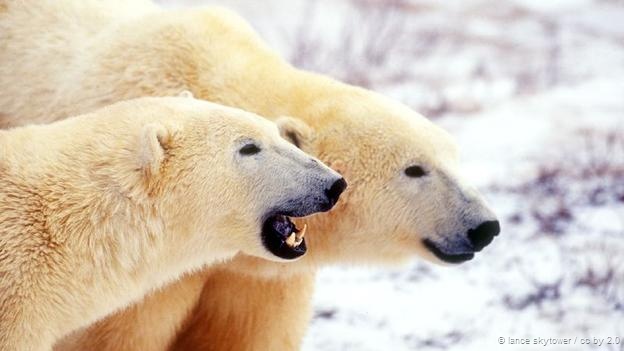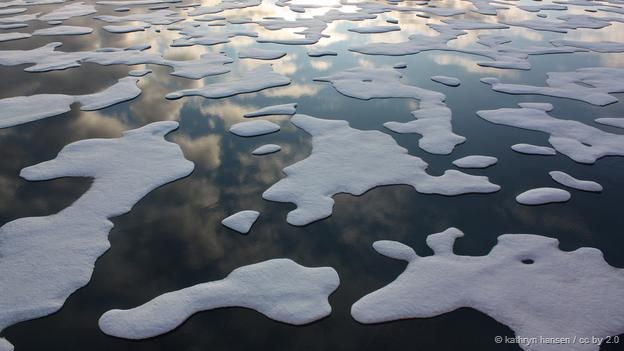It's November and that time of year when the sleepy town of Churchill, Manitoba, on the western shore of Hudson Bay in Canada, turns into polar bear central.Hundreds of polar bears, lean but lethargic - their last full meal eaten in the late spring - pass the hours wandering around aimlessly, mock fighting, or simply lying belly-up catching the dim rays of the Arctic gloaming. They are waiting until the ice freezes over and they can go and hunt seals.Outnumbering them are the tourists who've flown in from around the world to get a unique "up close and personal" view of one of the Arctic's most iconic species.And last, but not least, there's the scientists. While some scientists visit the "Polar Bear Capital of the World” to study the bears, others, such as Polar Bears International's Steven Amstrup, are there because they also see a unique opportunity to inform people about the plight of polar bears.Because polar bears, most scientists agree, are in trouble.Human-caused global warming is causing the Arctic sea, the bears' habitat and hunting ground, to melt and decline. If the trend of sea ice decline continues as it has done, at the rate of about 13 per cent a decade, then polar bears would suffer a loss of habitat, and consequently food.

"The best estimates we've got indicate that we'll probably lose somewhere around two-thirds of the world's bears somewhere around mid-century, just based on the simple fact that we're losing sea ice," says Andrew Derocher, a professor of biological sciences at the University of Alberta and past chair of the International Union for the Conservation of Nature’s (IUCN) Polar Bear Specialist Group.The bears simply depend on sea ice to make a living, Derocher says. "No sea ice means no seals. And no seals means no polar bears."Skating on thin iceDespite its size, Ursus maritimus, the largest member of the bear family, is ideally suited to life on ice, its double-layered coat and its furry-undersided paws insulating it from the chilly Arctic temperatures. A polar bear can stand up to 3 metres tall and weigh up to 600 kilograms - hardly the physique of a figure-skater - but it can move with grace and stealth across the ice surface and sneak up on its prey of ringed and bearded seals.
There are 19 subpopulations of polar bears in the world, 13 of which can be found in Canada. Some of these bears live year-round on the ice, but for populations such as the Hudson Bay bears, the ice proves an ephemeral habitat.
In this region, bears spend the winter months on the ice gorging their prey but, when the ice melts each year, they're forced onshore where they have insufficient food until the sea ice refreezes in the fall. And as the temperatures in the Artic have risen, the sea ice has begun to melt sooner and refreeze later, leaving the polar bears stranded on land for longer lean times.

"When I first started working in Hudson Bay in the early 1980s, the sea ice would have already formed along the shore quite nicely by now," Derocher says. "There were years when the bears were gone in the first week in November, but this year it is unlikely that we see any significant sea ice for at least a couple of weeks."
In the last 30 years, bears have increased the amount of time they are on land by almost 30 days - staying another day longer each year - according to Amstrup. That means the bears are coming ashore to face food shortages before they have stored enough fat to last through the season, he says.
"The bears just run out of energy," Derocher says. The longer summer fasting time impacts bear health and resilience, and influences reproduction rates, he says.
According to the United Nations' Intergovernmental Panel on Climate Change (IPCC), ice coverage is likely to fall below one million square kilometres by 2050. The current changes, and predictions such as these, led to the listing of polar bears in the US as an endangered species in 2008.
Already the numbers of bears in the western Hudson Bay have declined, Amstrup says. "This population is near the southern extreme of the polar bears' range and so it is one of the most vulnerable populations," Amstrup says. "If we don't get our act together soon we may not be able to save these bears."
Hope or hoax?
Although most scientists appear to agree with Derocher's grim outlook for the polar bear, there are a few that question it. One of the most vocal of these is Mitch Taylor who spent more than two decades as a polar bear researcher and manager for the Nunavut government.
"Are we just about to lose our polar bears? No we are not," Taylor says. "We are seeing 130 years of climate warming that has increased temperature of about 0.75 degrees and that has obviously affected the sea ice, but the polar bears don't seem to have been affected so far."
The crux of Taylor's argument is that the world’s polar bears are thriving, at least in terms of numbers. The current scientific consensus places the worldwide polar bear population between 20,000 and 25,000 animals, more polar bears than existed prior to the 1973 International Agreement worldwide restriction on polar bear hunting.
"This is the time the Inuit call 'The one with most bears'," Taylor says.
Derocher doesn't dispute the numbers but argues they don't tell the whole story.Back in the early 1800s there was commercial harvesting of polar bears, which led to a steady decline in their numbers, he says. The numbers may have increased since the hunting restrictions but they are still greatly depleted from pre-hunting levels.
In the Hudson Bay, when Derocher first started doing research in the region there were 1200 bears. Now there are barely 800. "The current status is the numbers have dropped by about a third," Derocher says. "It certainly doesn't seem like it's on a continuous precipitous climb."Overall, the number of bears that scientists can adequately monitor appears to be on a downward trajectory, Derocher says.
And what about the health of the bears? Research shows that the bears are becoming leaner and that fewer cubs are being born and surviving in the western Hudson Bay. "A population can't be healthy for long if its cubs aren't surviving," Amstrup says.
Not all the bear populations are suffering though, Amstrup says. Bears in the higher latitudes, such as those in the Davis Strait, are thriving. With warming, annual ice cover replaces the thick multilayer ice, making it more suitable for seals, the polar bears' main food supply. "We think that maybe many of the populations are still doing OK and we aren't seeing those effects yet," Amstrup says. "But you could liken it to the passengers on the Titanic. They were fat and happy until the Titanic slipped under the waves."
Current bear population numbers aren't really the problem. It is what is going to happen to bears in the future, Derocher says. He cites the international standard to consider conservation of a species, that of using the "three generation rule" looking forward in time. For polar bears, three generations is somewhere in the 36- to 45-year timeframe. In this timeframe, scientists predict rapid declines in sea ice.
Amstrup agrees. "There are none of us in the polar bear community that are standing up and saying it is a catastrophe right now, what we are talking about is the threat for the future," Amstrup says. "In the places where the ice has dramatically changed, we are seeing effects and, if we allow those changes to continue on to the higher latitudes, then it will affect all polar bears."
Does the past predict the future?
An additional argument against polar bear extinction lies in the theory that, as a species, polar bears have already survived warming periods. Using molecular genetics, Matthew Cronin, a genetics professor at the University of Alaska, in Fairbanks, US determined that polar bears split from brown bears, and became an independent species, about 1.2 million years ago.
"These results, combined with the fossil record, indicate that polar bears have been around as polar bears for at least 125,000 and maybe as long as several million years," Cronin says. "That means they've survived their loss of habitat previously so they could very well survive loss of their habitat in the future."It is a theory that Taylor also embraces, and one that Amstrup is quick to counteract. "We don't have any evidence that polar bears have experienced anything more than about a degree and a half temperature rise during their whole evolutionary history," Amstrup says.
And, according to most of the predictive models we will be close to 2 degrees Celsius warmer for a global mean temperature within 50 years, and certainly within 100 years, Amstrup says. "Polar bears just simply haven't experienced warming like this," he says.
Taylor argues that polar bears could survive warming of 1.5 degrees Celsius although he seems unable to articulate exactly how they would do that on an ice-less tundra. "I am not one of those that think that polar bears can just adapt to a terrestrial environment and eat goose eggs and vegetation and other carrion that they might find," Taylor says, "but I do think they would survive."
But how could they survive temperatures even warmer still? Such as 2 degrees Celsius? Taylor argues polar bears wouldn't see them. "I think that the climate models have exaggerated the warming that we are going to see from fossil fuels," he says.
And consequently, although some polar bear populations would suffer, there wouldn't be dramatic declines in numbers across all the populations, Taylor says. "Declines would be slow and incremental and we'd have to do adaptive management in these populations," he says. "Then when fossil fuels stopped being burned the planet would get cooler again."But it is not just the extent of warming, it is the speed at which warming would take place that poses a problem, Amstrup says. It took nearly 10,000 years to raise temperatures by 1 degree Celsius in the last interglacial period, he says. But the warming now is taking place over decades, leaving polar bears little time to adapt to the changing conditions."It makes it ridiculous for some people to say they have survived warm periods in the past so they'll survive warm periods now," Amstrup says. "It is a totally different ball game now."
Bears as the fuzzy face of climate changeIn reality, any argument about polar bear extinction reveals itself as being more about climate change than the extinction of the bears themselves.
"The polar bear is the fuzzy face of climate change," Amstrup says. "So a lot of people who don't believe that global warming is occurring, or deny that it is going to be a problem, like to cherry pick different things about polar bears, because if they can make it look like polar bears will be OK then by proxy they are kind of saying 'we don't have to worry about global warming'."
Taylor professed that he believed that climate warming and sea ice loss are reality. But closer inspection reveals that, in 2008, he signed the Manhattan Declaration on climate change, which argued that there was no conclusive evidence that emissions from industrial activity were causing climate change. However, Taylor's feelings for the bears he worked with for more than 30 years are evident.
"I don't think anyone has ever worked on polar bears who wouldn't rather cut off their arm than say something to harm polar bears, or let his personal feelings or his career interfere with getting what he thought was the best information out there for polar bears," Taylor says.
"I think that we all want to believe that things aren't so bad," Amstrup says.
That could be why, although the science doesn't appear to back up bear extinction denialist theories, so much media space and public attention is given them.
But, if we move the distraction of climate wrestling aside: What about the bears? Will the bears be around in 50 or 100 years' time?
Other areas in the Arctic and sub-Arctic that have sea ice in winter, but don't have polar bears, tell the story, Derocher says. In such regions the ice doesn't persist for long enough each year to sustain polar bears, he says. He points to areas in the southern parts of Norway and Sweden where the fossil records show that bears existed about 11,000 years ago. But now these regions are both ice free and bear free.
"It is really quite simple and I come back to it time and time again: It's just the habitat loss issue," Derocher says. "If there's not enough ice, we won't have bears. I think it's very clear that we're going to lose the vast majority of them, not within my lifetime, but certainly within the lifetime of children of mine."



